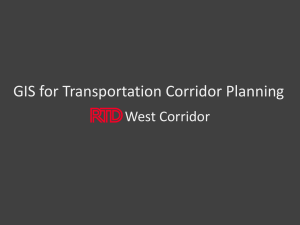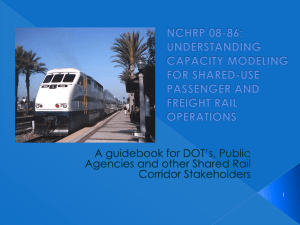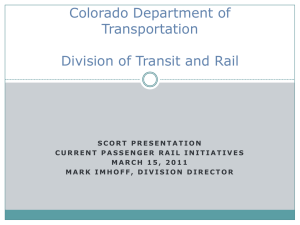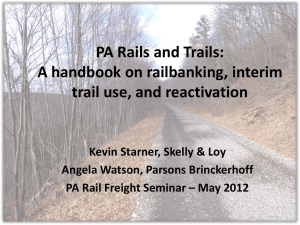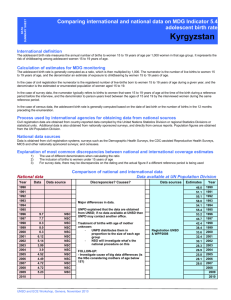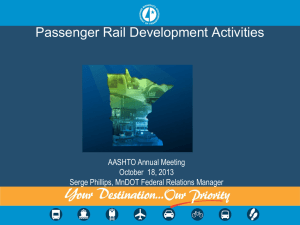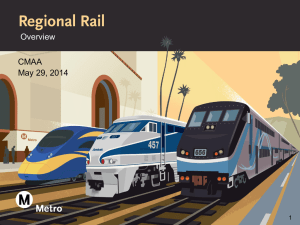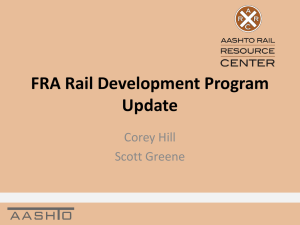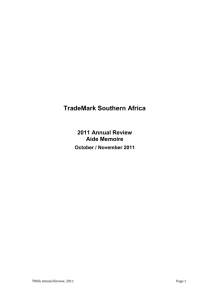NSC Capacity Building Training Workshop Jbg
advertisement
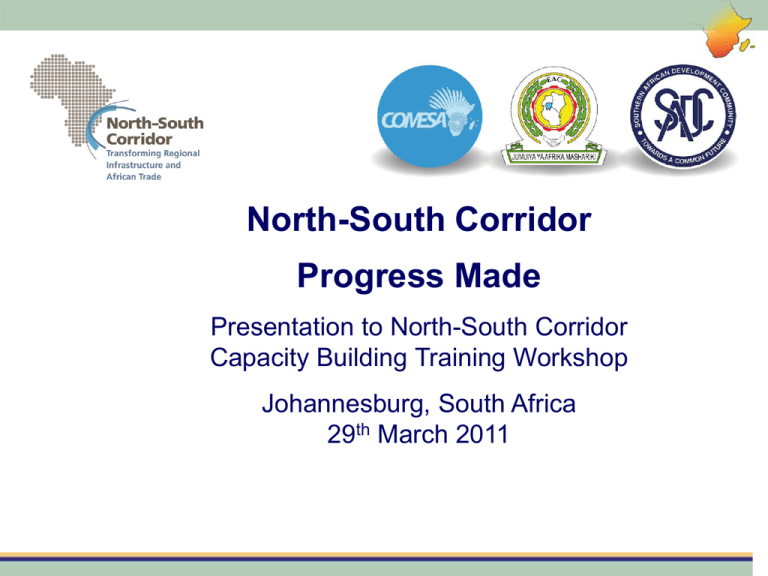
North-South Corridor Progress Made Presentation to North-South Corridor Capacity Building Training Workshop Johannesburg, South Africa 29th March 2011 TradeMark Southern Africa • TradeMark Southern Africa (TMSA) is a DFID funded Programme; • The overall objective of TMSA is to reduce poverty through trade led inclusive economic growth; • It focuses on two components- trade and infrastructure – corridor development; • Corridor Specific objective is to improve trade facilitation through: improved efficiency of trade flows along corridors (roads, railways, border crossings and ports); reduced transaction costs/ costs of trading; reduced transit times along the corridor including at border crossing. African trade – where we are now • Africa accounts for less that 2.5% of world trade and non-oil exports have been about 1% since 1992 - half of their 1980 value. The level of intra-African trade is also low - 10%, compared to about 40% in North America and about 60% in Western Europe. • Africa has the highest export product concentration and a high export market concentration reflecting continued reliance on primary commodity exports mainly to the EU, US, and China. • Africa ranks low on trade policy and facilitation performance and for logistics performance. • African markets remain fragmented and borders are difficult to cross, which prevents the emergence of regionally integrated industries and supply chains. Economic Challenge: • It costs about US$8,000 to ship a 20ft container from Durban to Lusaka and takes about 10-15 days – compare that to US$1,500 to ship the same container from Japan to Durban. • The region will remain a high cost producer unless the underlying causes of these costs of transport are addressed to open region for economic growth opportunities and deeper regional integration. • Inadequate and poor roads, railways, ports, inland waterways, airports, energy and telecommunications systems have been identified as being serious obstacles to intra- and inter-regional trade in eastern and southern Africa as they increase the cost of doing business and have a negative impact on trade and economic growth. Importance of the North South Corridor •The North-South Corridor links the Copper belt region of southern DR Congo and northern Zambia to the port of Dar es Salaam in Tanzania and the ports of Southern Africa. The corridor with its spurs, services eight countries- Tanzania, DR Congo, Zambia, Malawi, Botswana, Zimbabwe, Mozambique and South Africa. •NSC has generated a lot of interest and donor support as an Aid for Trade Pilot Programme which aims to improve both the state of physical transport infrastructure, the regulatory environment for trade and transport, and energy infrastructure. •Support for NSC was demonstrated at the international conference held in April 2009, in Lusaka, Zambia where donors and development institutions pledged $1.2 billion to finance the NSC Aid for Trade Programme. Infrastructure Requirements of NSC • Transport infrastructure requirements on the NSC alone are enormous - rehabilitation of roads and rail track; - new rail rolling stock; - improvements at border posts along NSC; and - ports. • There is also demand for new road and rail infrastructure, ICT and energy infrastructure. • NSC has been prioritised even under NEPAD. Why Prioritise? Example of Copperbelt imports/exports options Copper Belt 1 Rail to Lobito – railway line due to open in 2011 2 Rail to Dar es Salaam – TAZARA 3 Rail to Durban 4 Road to Harare and Rail to Maputo 5 Road to Harare and Rail to Beira 6 Road to Durban 7 Road to Walvis Bay There are also other road-rail combinations. There are, in addition, plans to increase the number of routes and ports. Will there be enough traffic to justify new corridors and harbours? Is there enough traffic to make these routes economical? Should we decide on the priority routes on a regional basis? Main Transport Corridors in Eastern and Southern Africa Ethiopia - Djibouti Northern Central Dar es Salaam Malanje Lobito-Benguela Nacala Namibe Trans-Caprivi Trans-Cunene Beira North-South Trans-Kalahari Maputo Priority NSC Roads – Roads Agencies Country Section Description Botswana Nata-Kazangula Botswana is currently financing the reconstruction of the worst sections but requests for funding have been sent to TMSA DR Congo KasumbalesaKolwezi The Director of Roads has stated that this section is being upgraded by government Nsipe-Zalewa Bwengu-Chiweta Karonga-Songwe KIA TO-Bunda TO Kasunga-KIA TO Malawi has requested assistance with the construction of all of these road sections. The Tripartite has been informed that all tender documents have been completed. However, the Malawian Authorities have yet to submit these documents to the Tripartite for evaluation. Tunduma-Dar Sections of this road are being rehabilitated using funds from Danida and World Bank Malawi Tanzania Serenje-Nakonde Zambia Lusaka-Chirundu Zimbabwe Beitbridge-V.Falls Harare-Nyamapanda The tender documents for the design for this road (613km) have been completed in 3 sections and will be financed by the EDF10 Regional Fund with COMESA as the Contracting Authority. The last section (about 23km) will be financed using a TTA grant leveraging DBSA loan finance. Zimbabwe have requested a design for the widening of these road sections. TMSA financed a condition survey and are awaiting a RFP. Example Lusaka-Chirundu Lusaka–Chirundu road. In 4 sections. Escarpment road already done. 2 sections (Lusaka-Kafue and Kafue to top of escarpment to be done by World Bank. Last section (bottom of escarpment to Chirundu to be finance through TTA + DBSA. Railways •Railway transport systems are operation under concession agreements in many countries in ESA. These agreements have not yielded the desired results. •The cargo share transported by rail has fallen to very low levels, 5% of all cargo, yet rail should be the cheapest mode of transport. The situation is unsustainable (it’s a failure). •Government may have to renegotiate the agreements and ensure that have a voice and can invest in infrastructure and also generate revenue from rail systems. •TMSA supporting the Tripartite on railways: -assisting TAZARA prepare a business plan; -preparing a rail track assessment; and -developing a policy paper on concessioning. Ports • Donors and IFIs working with Tanzania Ports Authority (TPA) to implement the TPA master plan. • Institutional reforms are resulting in average processing times being reduced. • Various proposals are prepared for coal terminals at Beira and Nacala. • Container terminals usually concessioned. • TMSA is supporting the development of a ports statistics database for PMAESA. Energy • Energy remains one of the most scarce resources in the region mainly due to lower levels of power generation. • The Southern Africa Power Pool is working with various partners including TMSA in mobilising resources to invest in more power generation and transmission projects which include: - ZAZIBONA - Zambia-Tanzania - Malawi- Mozambique - DRC- Zambia, etc • TMSA facilitated the Zambia-Tanzania-Kenya Interconnector now being funded under the EDF resources. Financing Infrastructure • The main infrastructure funds that can be accessed to finance regional infrastructure include: - The EU-Africa Infrastructure Fund - Funds from the Regional Development Banks (with DBSA being the main funder) - Funds from the African Development Bank – grants, loans and concessionary loans - World Bank – grants, loans and concessionary loans - Emerging Africa Infrastructure Fund (commercial lending). Financing Infrastructure - Tripartite Trust Account – a leverage fund supported by DFID (GBP67m) and DBSA (GBP1m) and other donors interested in supporting this. - COMESA Development Fund – portfolio closed-end fund with blending from the COMESA Infrastructure Fund. - SADC Project Preparation and Development Fund hopefully will soon be operational to help fund project development’ and - Private-Public Partnerships Other Areas covered Under the NSC programme other areas covered include: -Establishment of the Tripartite FTA- with much of the trade being serviced through the NSC and its spurs; -Trade facilitation where the RECs have agreed on one integrated trade facilitation programme Comprehensive Tripartite Trade and Transport Programmes (CTTTP); and - Elimination of NTBs – a presentation already made. Milestones on the North South Corridor: May 2007 NSC concept (holistic, sequenced, Aid-forTrade, integrated, transport solution) agreed by Tripartite Task Force. May 2008 Scoping study and projects presented to stakeholders in Pretoria, South Africa in the form of a GIS map. April 2009 High Level Conference in Lusaka – attended by 4 Presidents and most major donors and International Finance Institutions - and pledges of US$1.2billion made specifically to NSC projects, plus other non-specific pledges. May 2010 Tripartite Trust Account established; a pipeline of projects prepared and projects prepared for submission to the fund manager of the Tripartite Trust Account; GIS map layered by corridor; roads categorised by condition/level of preparedness; one-stop border posts implemented; rail projects identified and private sector interest gauged; financing identified for the PPU to establish the ZTK interconnector; and financing identified for the design of the SerenjeNakonde road. NSC Milestones Feb 2011 - Following projects prepared for financing: Kafue weighbridge, Chirundu approach Rds, Chirundu Rd (bottom of escarpment to border), - Projects completed or being implemented Chirundu border post (fibre optic links, bridge rehabilitation, fast-track booth, signage, partitioning, micro-wave link). - Projects under preparation - Tender documents prepared for Serenje-Nakonde Road; PIU design for ZTK completed and discussions with CEC started; Work to on TAZARA strategy/ business plan started; and Rds projects for Zimbabwe, Malawi & Botswana being submitted. For more information consult the NSC website at www.northsouthcorridor.org Thank You
